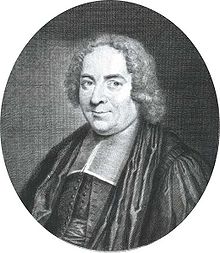Pierre de Varignon
Pierre de Varignon (also Pierre Varignon ) (* 1654 in Caen ; † December 23, 1722 in Paris ) was a French scientist , mathematician and physicist .
resume
He first became a clergyman in 1676, studied theology and philosophy at the Jesuit college in Caen until 1682 , and became a priest in Caen in 1683 . In 1686 he went to Paris to study mathematics at the Mazarin de Paris college . He became a member of the Department of Geometry of the Royal Academy of Sciences ( Académie royale des sciences ) in November 1688 . In 1699 he received his first title from King Louis XIV. In 1704 he became professor of mathematics. According to other, less credible information (Lexikon der Naturwissenschaftler) he became a professor in 1688. However, that would have been two years after starting his studies. From 1710 to 1712 he was sub-director and then director of the academy until 1719. In 1711 he became a foreign member of the Royal Prussian Society of Sciences . In 1714 he was elected a member ( Fellow ) of the Royal Society at the suggestion of William Jones .
In addition to mathematics, Varignon also dealt with theoretical mechanics and dynamics.
Mathematical work
In 1710 he found the Varignon phrase named after him . This is a theorem which says that the figure that you get when you connect the sides of any square with each other is always a parallelogram .
Varignon also described hyperbolic and logarithmic spirals in which the radius changes with the angle of rotation.
Physical work
Mechanics / statics
In 1688 he proved the composition of forces in a force parallelogram , which had already been described by Simon Stevin ("Law of the Force Parallelogram"). According to other sources, he did not find the “law of the parallelogram of forces” until 1710, but the parallelogram theorem is probably meant. - He also dealt with the moment of force (torque), the balance of liquids and their movement. Varignon is one of the pioneers of technical mechanics and, among other things, created the basis for structural engineering . In 1690 he also developed a mechanical gravitation explanation .
The set of moments also goes back to Varignon , which is also known after him as the Varignon set.
kinematics
In two publications by the Academy on July 5, 1698 and January 20, 1700, he defined the instantaneous speed ( speed of the instant) and the acceleration of a body using Leibniz's differential calculus on the direction of motion of a solid. He showed that it is possible to derive the acceleration of a body from its instantaneous speed by a simple differentiation . The acceleration is the derivative of the speed. He applied calculus to physical problems, where he was directly influenced by Newton's Principia. Newton used the infinitesimal calculus, but avoided its representation in his Principia, but gave a representation in geometric form.
Fonts
- Projet d'une nouvelle mécanique 1687 (or 1689)
- Nouvelles conjectures sur la pesanteur 1690
- Nouvelle mécanique, ou Statique 1725
- Éclaircissements sur l'analyse des infiniment petits et sur le calcul exponentiel des Bernoulli 1725
- Traité du mouvement et de la mesure des eaux jaillissantes 1725
- Eléments de mathématiques 1731
literature
- Karl-Eugen Kurrer : The History of the Theory of Structures. Searching for Equilibrium , Ernst & Sohn 2018, p. 27, p. 30ff, p. 213, p. 441, p. 453 and p. 1072 (biography), ISBN 978-3-433-03229-9 .
Web links
- Varignon and Wittenbauer parallelograms by Antonio Gutierrez from "Geometry Step by Step from the Land of the Incas"
- TU Freiberg: Pierre Varignon, from the lexicon of important mathematicians
- Digitized works of Varignon - SICD of the Universities of Strasbourg
- Entry for Varignon, Pierre (1654-1722) in the Archives of the Royal Society , London
Individual evidence
- ↑ Hibbeler: Technische Mechanik - Statik , Pearson, 12th edition, 2012, p. 149.
- ^ John J. Roche, The Mathematics of Measurement: A Critical History, Athlone Press / Springer 1998, p. 129
| personal data | |
|---|---|
| SURNAME | Varignon, Pierre de |
| BRIEF DESCRIPTION | French scientist, mathematician and physicist |
| DATE OF BIRTH | 1654 |
| PLACE OF BIRTH | Caen |
| DATE OF DEATH | December 23, 1722 |
| Place of death | Paris |
